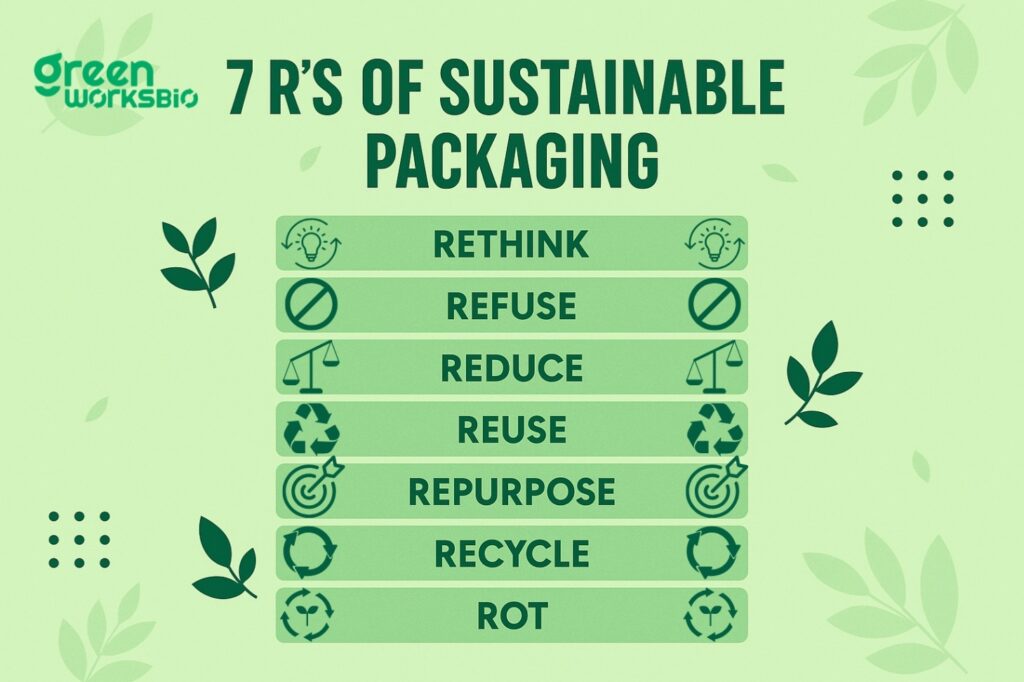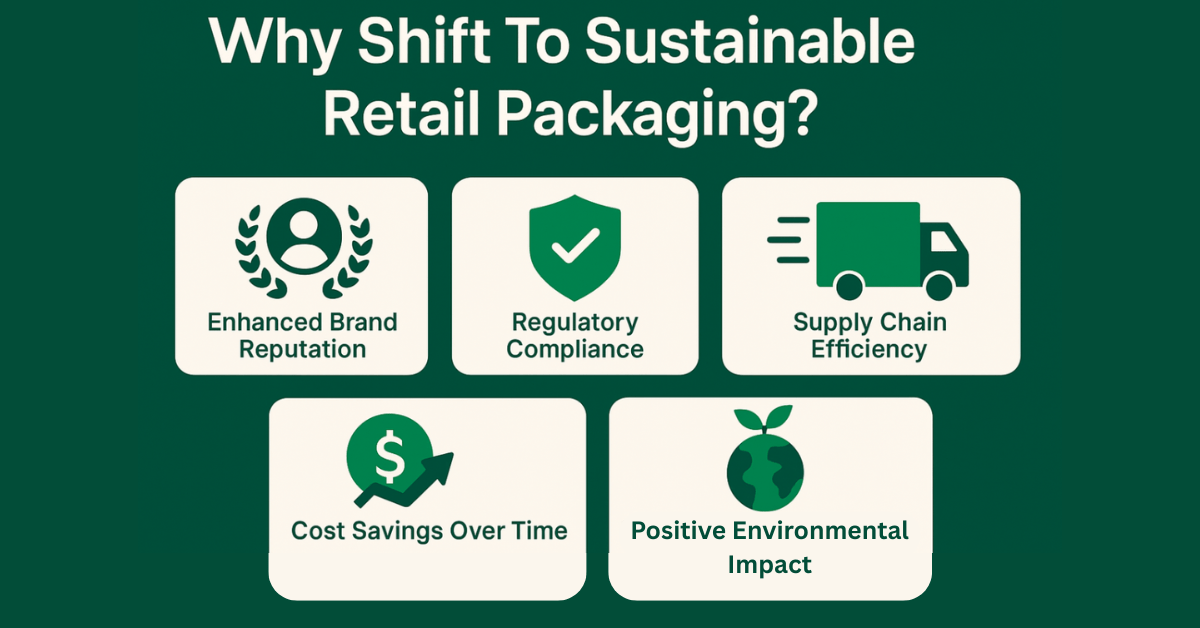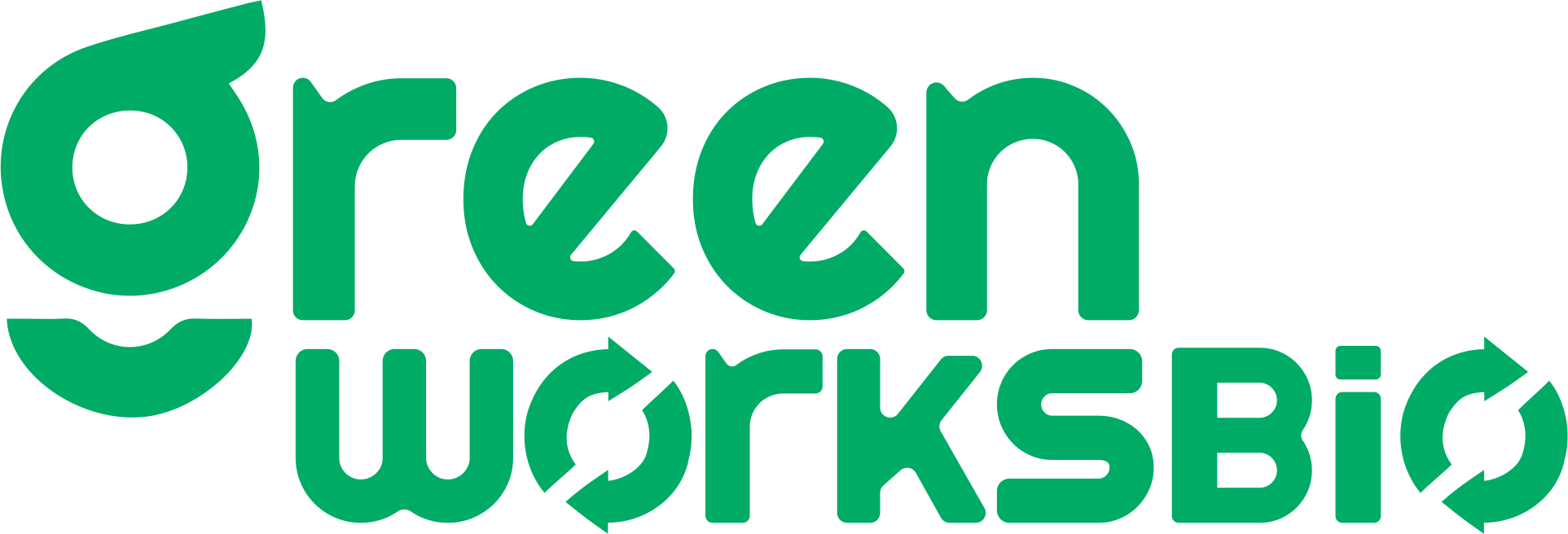| TL;DR
Sustainable retail packaging generates less waste, conserves resources, meets rising consumer and regulatory demands. Eco-friendly options include compostable retail bags, bio-based polymers, recycled paper, and plant-derived films. Global and regional laws are pushing retailers to move away from single-use plastics and adopt certified sustainable materials. Benefits include stronger brand reputation, compliance, long-term cost savings, and lower carbon footprints. Transitioning requires audits, goal setting, certified suppliers, eco-design, supply chain collaboration, and consumer education. Greenworksbio offers certified, scalable, and future-ready packaging solutions to help brands lead the retail sustainability shift. |
Today’s retail market demands far more than eye-catching designs, it calls for sustainable retail packaging solutions that actively reduce waste, conserve valuable resources, and align with global and national sustainability goals.
Shoppers are holding brands accountable, with 80 % of customers willing to pay more for sustainably produced or sourced goods, according to a PwC survey. (Source)
In this blog, we will unpack what sustainable retail packaging solutions mean, why making the switch matters, and how retailers can start their transition with Greenworksbio, a one-stop source for certified compostable sustainable retail packaging solutions.
What Are Sustainable Retail Packaging Solutions?
Sustainable retail packaging solutions use materials and designs that minimize environmental impact while still protecting and presenting products effectively. Instead of single-use plastics, they rely on eco-friendly alternatives such as compostable retail packaging, recycled paper, bio-based polymers, and plant-derived films.
What Are The Core Principles Of Truly Sustainable Retail Packaging?
In retail, sustainable product packaging solutions go beyond material choice. They follow core principles that guide every stage of the packaging lifecycle to ensure real environmental impact:
Reduce: Right-size packs, remove unnecessary layers, and choose lighter, responsibly sourced materials in the manufacturing process to cut waste and transport emissions.
Reuse: Create durable formats and return loops so packaging serves multiple cycles, reducing reliance on single-use plastics and supporting a circular system.
Recycle: Specify mono materials, clear labels, and widely accepted formats so packs are easy to collect and process, backed by credible certifications.
What Are The 7 R’s Of Sustainable Packaging?

The 7 R’s of sustainable packaging guide retailers in building a circular economy. Each principle helps minimize material use, lower the carbon footprint, and keep packaging systems efficient and environmentally friendly. Let’s break down each of the 7 R’s and see how they offer a comprehensive roadmap for sustainable retail packaging solutions:
| Principle | Retail Packaging Application |
|---|---|
| Rethink | Redesign packs and unboxing to avoid waste, simplify components and materials. |
| Refuse | Remove unnecessary inserts, overpacking, and hard-to-recover plastics. |
| Reduce | Right size cartons and mailers, light weight materials, cut void fill to lower freight and emissions. |
| Reuse | Shift eligible SKUs to returnable totes, refill packs, and durable delivery containers with simple returns. |
| Repurpose | Enable secondary use for boxes, wraps, or bags where practical before recovery. |
| Recycle | Specify widely accepted fibre, glass, metals, or sortable plastics with clear recycling labelling. |
| Rot (Compost) | Use certified compostable formats for food-soiled or organics where composting access exists. |
How To Choose Between Biodegradable, Compostable, Recyclable, And Reusable?
Biodegradable, compostable, recyclable, and reusable retail packaging are not interchangeable. Each differs in environmental impact, performance, and compliance. The table below compares them so you can choose what fits your product, customers, and goals.
| Type | Definition | Best Retail Use Cases | Key Considerations |
|---|---|---|---|
| Biodegradable Packaging | Breaks down naturally into water, CO₂, and biomass under certain environmental conditions. | Apparel packaging, non-food items, dry goods. | Breakdown time depends on the environment, and may leave residues if not certified. |
| Compostable Packaging | Decomposes under specific composting conditions to create nutrient-rich soil with no toxic residue. | Fresh food, takeaway containers, compostable retail bags, produce and transparent inner bags, liners, and tableware. | Must meet EN 13432 or TÜV Austria OK Compost standards, needs access to composting facilities. |
| Recyclable Packaging | Designed to be collected, processed, and turned into new products (e.g., paper, glass, certain plastics). | Paperboard cartons without plastic lamination, corrugated shipping boxes, paper mailers, glass jars, aluminium cans, and PET bottles | Must be accepted in local recycling systems; clear labelling is essential. |
| Reusable Retail Packaging | Durable packs designed for multiple use cycles via return, refill, or redeployment | Bottles, retail product wraps, and mailing envelopes. | Reduces the need for fresh materials, may require blending with raw material for strength. |
Why Retailers Must Shift To Sustainable Packaging Solutions?

Adopting sustainable retail packaging solutions delivers measurable advantages for brands, customers, and the wider supply chain. From strengthening brand image to improving operational efficiency, these benefits make the business case for switching clear and compelling.
- Enhanced Brand Reputation – Shoppers are increasingly choosing brands that demonstrate environmental responsibility and commitment to sustainability and conserving natural resources. If you need a premium look, choose a friendly packaging solution that feels good in hand and still recovers well.
- Regulatory Compliance – With stricter laws on single-use plastic packaging and the waste it generates, sustainable options such as compostable retail bags help retailers meet both local and international compliance requirements.
- Cost Savings Over Time – While initial investment may be higher, reducing material use, optimising designs, and avoiding regulatory penalties can lead to savings in the long run.
- Supply Chain Efficiency – Lightweight, well-designed, sustainable packaging reduces transportation costs and carbon emissions, streamlining sustainable shipping across your network.
- Positive Environmental Impact – From conserving resources to reducing landfill waste, sustainable packaging plays a direct role in building a circular economy.
How Can You Build A Zero-Waste Retail Packaging Operation?

Adopting sustainable retail packaging solutions needs planning, supplier alignment, and compliance. Whether you pilot compostable courier bags, switch to eco-friendly retail packaging, or develop new sustainability practices to redesign your system, follow the steps below to make the shift smooth and measurable.
Step 1: Audit Your Current Packaging
If you spot a lot of packaging with no protective value, remove it and track the weight saved.
Step 2: Set Clear Sustainability Goals
Set goals with numbers and dates, for example 50 percent compostable in 12 months. Cut weight, raise recycled content, and meet EPR (Extended Producers Responsibility) rules under India’s Plastic Waste Management framework.
Step 3: Select Certified Sustainable Materials
Choose certified compostables like PLA or PBAT under IS/ISO 17088 or EN 13432. Use recyclable mono materials like kraft paper or PET with PCR. Get certificates from CPCB-recognized labs.
Step 4: Redesign For Minimal Impact
Use a fit-for-purpose matrix to pick the right packaging by product risk, moisture, and recovery path.
Step 5: Collaborate Across The Supply Chain
Align suppliers on specs and real-world performance. Work with PROs for EPR and with logistics to keep packs durable and resource efficient.
Step 6: Educate Consumers
Use QR codes, icons, and short on-pack cues to show disposal steps. Highlight certifications and repeat the message online and in-store.
Step 7: Monitor, Report, And Improve
Track virgin plastic, certified share, damage rates, and disposal compliance. Share clear metrics so customers can see the positive impact of your changes.
Ready To Lead The Retail Shift To Sustainable Packaging?
As consumer expectations rise, regulations tighten, and climate concerns intensify, the retailers who embrace sustainable retail packaging solutions today will be the market leaders of tomorrow.
The question isn’t if you should make the switch, but how fast you can move to capture the environmental, regulatory, and reputational benefits of sustainable packaging. At Greenworksbio, we deliver certified, scalable, and future-ready solutions that help brands transition seamlessly without compromising on quality or compliance.
Start leading the shift. Contact us to design retail packaging products that perform for your products and the planet.
Conclusion
The best retail packaging balances protection, cost, and a clear end-of-life. Sustainable retail packaging solutions help you cut waste, lower emissions, meet EPR, and build customer trust. Start with an audit, set clear goals, choose certified materials, and pilot on high-rotation SKUs before scaling across your range.
Frequently Asked Questions
Are compostable retail packaging solutions right for all products?
Compostable packaging suits short shelf life, low-moisture items like fresh food and light goods. For more extended protection or substantial moisture barriers, consider other materials or certified compostable films, and assess product risk and environmental impact before choosing biodegradable packaging.
Can small businesses afford sustainable packaging?
Yes. Optimize design, partner with local suppliers, and buy in bulk to control costs. Many small businesses find that eco-friendly products and packaging pay back through lower waste, better shipping efficiency, and stronger loyalty.
What mistakes do retailers make when switching to sustainable packaging?
Skipping recyclability checks, underestimating process changes, and neglecting staff training. Run a packaging audit, choose certified materials, and involve teams to ensure smooth, sustainable packaging systems.
Why are eco friendly retail packaging materials important?
It uses materials and designs that cut environmental impact, like compostable retail bags, recyclable paper packaging, or packs with post-consumer recycled content, including eco-friendly packaging materials. It reduces waste, supports compliance, and meets rising demand for responsible choices.
Is sustainable packaging more expensive?
Sometimes upfront, but savings accrue from less waste, lower shipping costs, and easier compliance. As demand grows, economies of scale make sustainable packaging the best packaging solution.
What are the 3 R’s of sustainability?
Reduce, reuse, recycle. Use less, extend product life, and turn materials into new items to conserve resources and cut waste.
Which sustainable packaging materials are gaining traction?
Bioplastics like PLA and PHA, paper and paperboard, moulded fibre, and plant-based films. These eco-friendly packaging options support recyclable and compostable materials, which lower the carbon footprint.
How are compostable retail bags different from plastic bags?
They use plant-based or biodegradable polymers such as polylactic acid (PLA) or PBAT that break down into non-toxic compost in industrial or home systems. Regular plastic bags persist for decades, while compostable packaging solutions, like compostable bags, decompose in months when processed correctly.
What are the current trends in sustainable packaging solutions?
Branded, custom packaging using compostable, recyclable, or recycled materials. Gen Z drives demand for transparency, labels, and minimal designs that support a circular economy.
What are the most innovative compostable or biodegradable retail packaging options available right now?
Top picks include home compostable mailers and carry bags, PLA or PLA PBAT transparent bags, PHA and seaweed-based films, moulded fibre trays from sugarcane bagasse, and mycelium cushioning.
What mistakes happen when switching to sustainable packaging, and how do you avoid them?
Common issues are poor material fit, limited training, and weak customer guidance. Audit your system, train staff, and choose certified, eco-friendly packaging aligned to clear sustainability goals.

